- Viscosity Measurement
- Rubber Density Measurement & Preparation
- Density Measurement
- Fire Properties Testing for Plastics Materials
- What is UL94 – Standard for Safety of Flammability of Plastic Materials for Parts inDevices and Appliances testing
- Pendulum Impact Test Systems for Plastics
- Plastic Specimen Preparation for Impact Testing
- Heat Distortion Temperature and VICAT Softening Temperature
- Measuring Melt Flow Index of Thermoplastic Polymer
- Innovative Method for Analyzing Oxygen Transmission Rate (OTR)
- Innovative Method for Analyzing Water Vapor Transmission Rate (WVTR)
- Sealing Properties of Packaging Materials
- Heat-sealing of Packaging Materials
- Method Comparison of Impact Resistance of Plastic Film
- Abrasion Resistance Test
- Scratch Resistance
- Rubber Test Properties
- Plasma Surface Treatment for Packaging
A rheometer is a laboratory device used to measure the way in which a liquid, suspension or slurry flows in response to applied forces. It is used for those fluids which cannot be defined by a single value of viscosity and therefore require more parameters to be set and measured than is the case for a viscometer.
A viscometer employs a mechanical bearing that limits the speed and torque capabilities of the instrument, whereas a rheometer uses a low friction air bearing.
A rheometer measures the stress-strain relationship to understand the flow/deformation properties of a material. A commercial rheometer can be divided into an analytical rheometer and an experiential rheometer. Most rheometers use the same measurement geometry (cone, plate, parallel plate, concentric cylinder, etc.) and have a comparable measurement range. However, the design difference between different rheometers varies greatly. Commercially, there are different types of rheometer available in the market; each rheometer follows a different principle such as rotation, creeping, relaxation, swinging, and other methods.
Rheometers can be of two types: controlled-stress and controlled-strain rheometers. A controlled-stress rheometer applies a torque either to control the stress at a desired level or to drive the strain to a desired amount. In this kind of rheometer, the material is placed between two surfaces: a bottom surface, which is fixed and a top surface, called the geometry, which rotates. In the controlled-stress rheometer, the torque or stress is the independent variable that is applied to the geometry. In the controlled-strain rate rheometer, the material is placed between two plates. The bottom plate moves at a fixed speed and the torsional force produced on the top plate is measured. Hence, for this case, the strain rate is the independent variable and the stress the dependent one. Here it is worth noting that a controlled-stress rheometer is a better approach for determining yield stress.
Standards
ASTM D3835 – Standard Test Method for Determination of Properties of Polymeric Materials by Means of a Capillary Rheometer

Rubber Properties Testing for accurate result
Specific Gravity Tester is an advanced Density testing equipment for measuring solid and liquid samples with high precision sensor and auto-weighing function.
These test methods cover the qualitative and quantitative analysis of the composition of rubber products of the “R” family; describe the determination of the specific gravity (relative density) and density of solid plastics in forms such as sheets, rods, tubes, or molded items; and the determination of the density and relative density of non-cellular plastics in the form of sheet, film, tube, moulded objects, and moulding powders, granules and pellets.
The Density Meter helps your lab maintain tight quality control expectations by reliably measuring the specific gravity/density of cured compounds. The Density Meter utilizes the compounds weight in air and in water to account for any environmental differences during testing, resulting in higher quality standards and increased precision. Rapid readings help reduce water absorption which translates into a more accurate reading, ensuring the customer can always trust the measured data. Additionally, to ensure external atmosphere patterns are accounted for, the specific gravity of the liquid is corrected for temperature. Once the data is created, the software organizes data into reports and can perform analysis that allows the user to statistically control the manufacturing process.
Inconsistent sample preparation is both the easiest and most avoidable source of error in the testing environment. Varying sample mass and shape between tests introduces unnecessary variation to results. The constant volume cutter is a simple solution to ensure identical samples resulting in more reliable data allowing tighter specifications and superior final products.
Sample Cutter produces a constant volume rubber sample in seconds. It’s samples are ideal for MDR, RPA, and MV instruments when repeatability of rheometer and viscometer testing is necessary. With two sample cutter options to choose from, samples fit perfectly in the corresponding sample trays.
Standards
ASTM D297 – Standard Test Methods for Rubber Products—Chemical Analysis
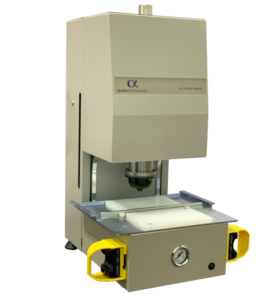
Sample cutter ensuring consistency and accuracy

Automated Rubber Gravity Tester
Density Gradient Columns are used to measure the density of plastics and other objects extremely accurately to 6 decimal places.
Density Gradient Columns offer the ability to read density measurement extremely accurately, typically 6 decimal places using at least 2 miscible liquids to build your density gradient. Calibrated glass floats are then used to calibrate the column before the test material is added. Once at equilibrium the density of the material can be found.
The unit offers a simple way to determine density to 6 decimal places using advanced Microprocessor technology to give simple but accurate density measurement readings at the touch of a button. The apparatus is available as 3 and 6 column units.
To ensure results accuracy the Density Gradient Apparatus is supplied with digital temperature control to ensure the temperature of each column is at 23°C +/- 0.1°C. For ambient temperatures in excess of 23°C the integrated cooling coil can be used in conjunction with an optional water chiller unit, so the correct temperature can be maintained.
To build each glass column with a fluid of a known density range a variable speed peristaltic pumped filling system is supplied with the apparatus. Column filling speeds are variable from 0.5ltrs/hr to 1.5ltrs/hr to keep the gradient accurate. The density range of the column is formed by mixing two fluids having different densities in the supplied glass flasks. The resulting solution has a density which when introduced into the column increases uniformly from top to bottom. Calibrated glass marker floats of precise known densities are introduced into the column and sink to a point where the density matches that of the solution.
More
A linear encoder which is attached to a trammel guide is used to calibrate the gradient of the column by focusing the optical microscope onto the centre of the calibrated float and entering the floats density value into the microprocessor. Once test samples have been introduced into the column and have reached a point of static equilibrium, they are accurately sighted using the microscope. The resultant density of the sample is obtained and displayed on the LCD without the need for complicated graphs. Test results can be downloaded via the RS232 serial interface connector to an optional thermal printer.
To remove the samples and glass marker floats simply turn on the automatic sweep mechanism and wait for the items to be extracted from each column. Particles and floats are removed at a slow speed, so the gradient of each column is not damaged by the sweep basket. To replace the floats and new samples into the column simply reverse the sweep motor and lower them into the column.
The Gradient of the column can be calibrated & checked at any time as the calibration procedure stores the values in the microprocessor ensuring that density values of your samples remain accurate to the column. If the density gradient of the column changes at any time the column can be quickly re-calibrated saving time or the necessity to create a new gradient for the column. Depending on use or age the density distribution of the column can remain stable for up to 40 weeks.

Benchmark for accurate density measurement
Plastics used in most industrial and transport applications and particularly those used in higher fire hazard environments, are compounded with flame retardants to enhance their fire performance.
Several methodologies have been developed to assess the burning characteristics of the materials so that performance of the plastics themselves and the products into which they are made can be comparatively assessed. Some of these methods are simple flame tests and others can be used in numerical models.
Listed below are some flammability tests that are widely used in the industry to measure different fire response characteristics:
- Calorimeter – measure heat release rate, time to ignition, mass loss rate, smoke release rate, effective heat of combustion of plastics materials
- Oxygen Index – measure the minimum oxygen required to marginally support combustion
- UL 94 Horizontal/Vertical Flame Test – measure flammability characteristics of plastic and film materials
- UL 1581 Vertical Wire Flame Test – test flammability of cable materials
- Radiant Panel Flame Spread – measure the surface flammability of building products and cellular plastics by using gas-fired radiant heat panel
- Toxicity (or Corrosivity) Test– evaluate the potential fire hazard (toxicity) of plastics products.
- Smoke Density – measure the relative amounts of smoke produced by the burning or decomposition of plastics
- Elevated Temperature Oxygen Index – oxygen index test at elevated temperature condition

Cone Calorimeter
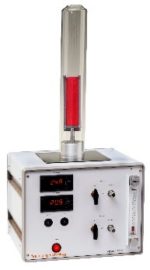
Oxygen Index Tester

UL94 Chamber

UL 1581 Vertical/Horizontal Wire Flame Test

Radiant Panel Flame Spread Apparatus

Combustion Toxicity Test Apparatus

Smoke Density

Elevated Temperature Oxygen Index – ISO 4589-3
Plastics used in most industrial and transport applications and particularly those used in higher fire hazard environments, are compounded with flame retardants to enhance their fire performance. Several methodologies have been developed to assess the burning characteristics of the materials so that performance of the plastics themselves and the products into which they are made can be comparatively assessed. UL 94 tests are some
flammability tests that are widely used in plastics industry to measure the fire response characteristics.
The UL 94 tests are conducted on plastic materials to measure flammability characteristics, giving a preliminary indication of their suitability for a particular application. Material can be tested either horizontally or vertically with the vertical test configuration being more onerous. The highest classification possible in the vertical test configuration is ‘V-0’ which means a material must stop burning within 10 seconds and drips of particles that fall must not be inflamed.
The UL94 tests determine 12 flame classifications of materials for specific applications
- Six of the classifications relate to materials commonly used in manufacturing enclosures, structural parts and insulators found in consumer electronic products (5VA, 5VB, V-0, V-1, V-2, HB).
- Three of the remaining six classifications relate to low-density foam materials commonly used in fabricating speaker grills and sound-deadening material (HBF, HF-1 and HF-2).
- The last three classifications are assigned to very thin films, generally not capable of supporting themselves in a horizontal position (VTM-0, VTM-1, and VTM-2). These are usually assigned to substrates on flexible printed circuit boards.

Comparison between V-Test and VTM Test

UL94 Chamber
Before plastics are incorporated into more complex manufactured products, they must first meet the rigorous standards of the foundries, compounders and moulders that produce them.
The purpose of an impact test is to determine the ability of the material to absorb energy during a collision. This energy may be used to determine the toughness, impact strength, fracture resistance, impact resistance or fracture resistance of the material depending on the test that was performed and the characteristic that is to be determined. These values are important for the selection of materials that will be used in applications that require the material to undergo very rapid loading processes such as in vehicular collisions.
For a single impact test the three most popular types of test are the Charpy V-notch test, the Izod test and the Tensile Impact test. These three tests all essentially determine the same characteristics of the material but differ in the orientation of the test sample which causes the sample to be stressed in different directions and involve a known weight released from a known height colliding with the specimen in its test fixture. All these tests are useful in determining the impact mechanics of the test specimen.
Test Specimens:
- Plastics
- Rubber
Test Specimens
- ISO 179
- ISO 180
- ASTM D6110
- ASTM D256
- ASTM D4812

Charpy & Izod Test
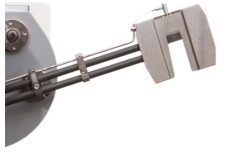
Impact Hammer
Impact tests are employed to measure the toughness of a specific material. A material’s toughness is a characteristic of its ability to absorb energy in the event of plastic deformation. There are different types of impact tests.
- Charpy test (ISO 179-1, ASTM D6110)
- Izod test (ISO 180, ASTM D256, ASTM D4508, ASTM D4812)
- Impact tests (ISO 8256, ASTM E1822)
Sample preparation play an important role in determining a good starts of a testing. The specimens can be either Dumbbell Type or Rectangular Type. BS EN ISO 2818 establishes the general principles and procedures for notching test specimens for impact testing. Notching machines are equipped with notch cutter to notch specimens and side cutter to cut off the ears of the Dumbbell Type Test Specimen.
Test Standard:
BS EN ISO 2818

Notching Machine
The heat distortion temperature (HDT) is the temperature at which a polymer or plastic sample deforms under a specified load. It gives an indication at what temperature materials start to “soften” when exposed to a fixed load at elevated temperatures. This property of a given plastic material is applied in many aspects of product design, engineering and manufacture of products using thermoplastic components.
Test Standard: ISO 75, ASTM D648
Test Material: Ethylene vinyl acetate, polystyrene, high-density polyethylene, nylon, polypropylene, ABS, acrylic, polycarbonate, PMMA, polysulfone, acetal copolymers, etc.
The VICAT softening temperature is the temperature at which a flat-ended needle penetrates the specimen to the depth of 1 mm under a specific load. The temperature reflects the point of softening to be expected when a material is used in an elevated temperature application.
Test Standard: ISO 306, ASTM D1525
Test Material: Thermoplastic material for example Bakelite, polyester, polyurethane, etc.

HDT Vicat Machine
The Melt Flow Index (MFI) is a measure of the ease of flow of the melt of a thermoplastic polymer. It is defined as the mass of polymer, in grams, flowing in ten minutes through a capillary of a specific diameter and length by a pressure applied via prescribed alternative gravimetric weights for alternative prescribed temperatures. Polymer processors usually correlate the value of MFI with the polymer grade that they have to choose for different processes, and most often this value is not accompanied by the units, because it is taken for granted to be g/10min.
The test results are specified as below:
- MFI = Melt Flow Index or MFR = Melt Mass-Flow Rate
- MVI = Melt Volume Index or MVR = Melt Volume-Flow Rate
Test Standard
- ISO 1133: Plastics - Determination of the melt mass-flow rate (MFR) and the melt volume-flow rate (MVR) of thermoplastics
- ASTM D1238: Standard test method for melt flow rate of thermoplastics by extrusion plastometer
- JIS K7210: Plastics - Determination of the melt mass-flow rate (MFR) and the melt volume-flow rate (MVR) of thermoplastics

Melt Flow Tester
The Ambient Oxygen Ingress Rate (AOIR) method, can measure the permeability of oxygen through films in finished packaging. The rate at which oxygen passes through a packaging film is a key factor for food products packaged under a modified atmosphere designed to exclude oxygen and inhibit the growth of microorganisms, thereby prolonging the shelf life of the product. Most existing techniques measure oxygen permeability of film before it has been incorporated into the package – where the process of heating, stretching and forming can affect the film’s properties.
Sensor:
0.05 to 432,000 cc/(m2 • day), 0.0006 to 28,000 cc/(100 in2 • day), 0.00004 to 2000 cc/(pkg • day), 0.005 Resolution cc/(m2 • day)
Applications:
Barrier Film, PET Bottles, Containers, Canisters, Bags, Flexible pouches
Test Standard
- ASTM D3985
- ASTM F1927
- DIN 53380-3
- JIS 7126
- ASTM F1307
- ISO CD 15105-2

OTR Machine
There are many industries where moisture control is critical. Moisture/water vapor sensitive foods and pharmaceuticals are put in packaging with controlled WVTR to achieve the required quality, safety, and shelf life. Key factors to understand material permeation include thickness of the material and environmental factors such as relative humidity and temperature.
Sensor:
0.002 to 10 g/(m2 • day) Unmasked, 0.02 to 70 g/(m2 • day) Masked, 0.00001 to 0.05 At 50cc flow up to 0.5 g/(pkg • day) at 10cc flow, 0.001 Resolution g/(m2 • day)
Applications:
Barrier Film, PET Bottles, Containers, Closures Bags, Flexible pouches
Test Standard
- ASTM F3299-18
- ASTM F1249 (modified)
- ISO 151106-3
- DIN 53122-2

WVTR Machine
Hot Tack is the strength of a heat-seal immediately after sealing, that is, before it has cooled down and reached its maximum strength. Conventional testing with a separate heat sealer and tensile tester seldom correlates with the strength of a hot seal as it is first exposed to stress on a packaging machine. The Hot Tack Tester has been designed for testing the heat seal strength under accurately controlled conditions.
The Hot Tack Tester is a highly sophisticated instrument for testing sealing properties of packaging material. It is being used in research and development as well as in Statistical quality control (SQC)/ Statistical process control (SPC) applications for raw materials; semi finished goods and finished packaging products.
The Hot Tack Tester permits evaluation of sealability and hot tack under a broad range of testing conditions to optimize packaging machine settings and to ensure consistent quality of the product. The instrument is also a practicable and helpful tool to packaging material manufacturers and end-users for incoming material inspection and for obtaining optimal production line speed.
Computerized control of the parameters enables simulation of different packaging machines. An extensive adjustment range of parameter values enables testing of various materials used in different applications.
The values of the following parameters are user-selectable
- Sealing Temperature
- Sealing Time
- Sealing Pressure
- Cooling Time
- Peeling Speed
- Sample width

Hot Tack Tester
The heat-sealing machine determines the heat sealability of coated paper, aluminium and plastic films, as well as other heat-sealable combination films, which allows you to determine the optimum sealing parameters for these film types quickly.
The heat-sealing machine was designed to simulate heat sealability under realistic conditions. You can specify the sealing parameters – temperature, force and time. Special design measures guarantee that the two sealing jaws are parallel. The heating bar and the sealing jaw are designed as two separate entities, to make it easy to exchange the sealing jaws.
Selectable sealing parameters with wide ranges: sealing times from 0.1 to 50.0 seconds. The sealing temperatures can be pre-selected separately for the upper and lower sealing jaws to meet your requirements, ranging from room temperature to 300°C. The sealing force ranges from 40-1000 N.
Freely programmable sealing parameters: The new control system lets you call up a maximum of nine self-defined sealing parameters, increasing the reliability of your sealing process even more.
Optimised pneumatics and increased internal time resolution: Further optimised pneumatics and increased time resolution for the control system, the accuracy of short sealing times is improved even more.
Interchangeable sealing jaws for every requirement: A wide range of different sealing jaws to meet varying requirements. You can change the sealing jaws in a few simple steps.
Secure and ergonomic operation: A clear control panel and a large, light LCD display ensure that you can work with the HSG-CC securely and reliably. Your work is streamlined and ergonomic, as the press on the heat-sealing machine stays unlocked for 30 seconds after each sealing.
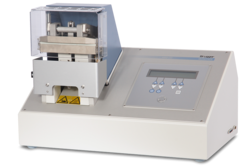
Heat Seal Machine
Impact Resistance is the resistance of a plastic to fracture by shock loading. The ability of a plastic film to withstand an impact load depends on its toughness. There are different impact testing techniques that are used to determine the impact resistance of plastic materials. In general, they can be broken into two categories, one being free falling weight and the other being pendulum impact.
Both methods are used to measure the impact resistance of plastic film (though in different mechanism).
Packaging Materials:
It is widely used in plastic industry doing the packaging material as one of the biggest challenges for plastic bag producers is developing advanced technologies that reduce costs and increase impact resistance of the packaging material that may be subject to impacts during these manual movements.
QA/QC on Finished Plastic Product:
Fabricating process can influence the impact strength. The flow behaviours of the material during the filling mold, specimen geometry, impact properties of the unoriented material are important in governing the impact behaviour. Therefore the impact strength of the finished product may need to be tested in the usual QA/QC.

Falling Dart Impact

Pendulum Impact Tester
This tester is used to evaluate the feathering of paper and also abrasion endurance and color transfer characteristic of planographic ink.
Attaching the abrading paper and after it has been abraded, the operator is to check the abrading surface to evaluate the characteristics of the test specimen.
Standard: JIS-K5701
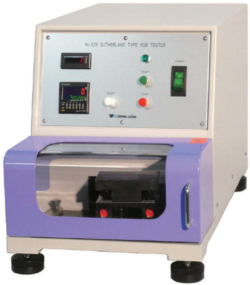
Abrasion Resistance Tester
This tester is used to evaluate the hardness of coated film according to the testing machine method.
Scratching the paint surface with a pencil attached at a 45° angle, the operator is to determine the hardest pencil that does not tear or damage the coated film.
The tester can also be used to evaluate the hardness of decorative sheet and resistance to solvents on enameled wire.
Standard:
- JIS-C3003, C3216-4,
- JIS-D0202,
- JIS-K5400, K5600-5-4, K5651, K6894, K6902,
- ASTM-D2197, D3363,
- ISO-15184,
- IEC-60521-4

Pencil Scratch Tester
Quantum Technologies Global offer testing solutions and instruments for existing test standards in rubber industry, serving different purposes from R&D, Processes to Quality Control. Rubber material properties which are covered in our testing solutions includes:
1. Cure
Related testing standards: ASTM D2084, ASTM D5289
2. Density
Related testing standards: ISO 2781
3. Dispersion
Related testing standards: ASTM D7723, ISO 11345
4. Dynamic Properties
Related testing standards: ASTM D6601, ASTM D7605
5. Hardness
Related testing standards: ASTM D1415, ASTM D2240
6. Physical Properties
Related testing standards: ASTM D412, ASTM D413, ASTM D429, ASTM D575, ASTM D790, ASTM D885, ASTM D1414, ASTM D4482, ISO 527, ISO 7743, ISO 11339, ISO 11345
7. Processability
Related testing standards: ASTM D3346, ASTM D6204
8. Scorch
Related testing standards: ASTM D1646
9. Stress Relaxation
Related testing standards: ASTM D6048
10. Viscosity
Related testing standards: ASTM D1646, ASTM D5099

Various Testing Parameter in Rubber Industry
Plasma pretreatment has proven to be a highly efficient process for the packaging industry. Plasma activation in our systems creates perfect surface characteristics for process steps such as printing, bonding or foiling. When it comes to printing and bonding of non-polar materials such as PP, PE or recycled materials, plasma pretreatment ensures cost-effective and environmentally compatible production.
Frequent applications of plasma in automotive engineering:
i) Cleaning of packaging surfaces before printing
ii) Activation of PE coat or UV paint before bonding
iii) Surface activation of packaging foil before printing/activation/barrier coating






